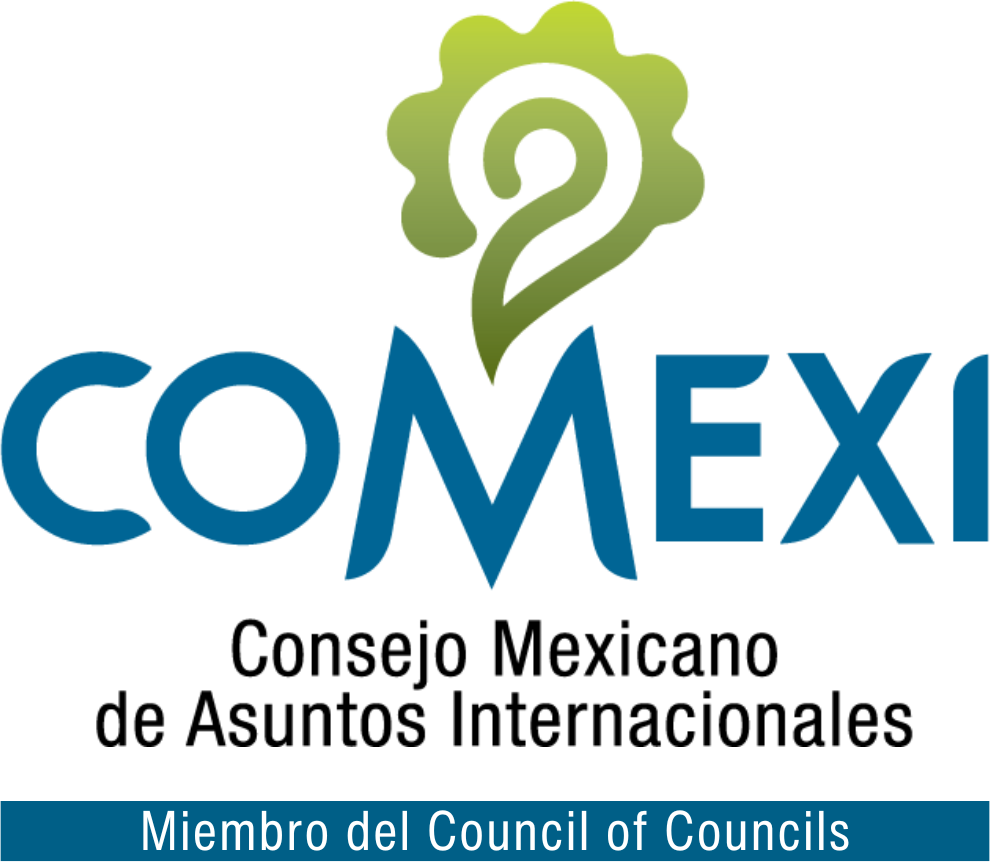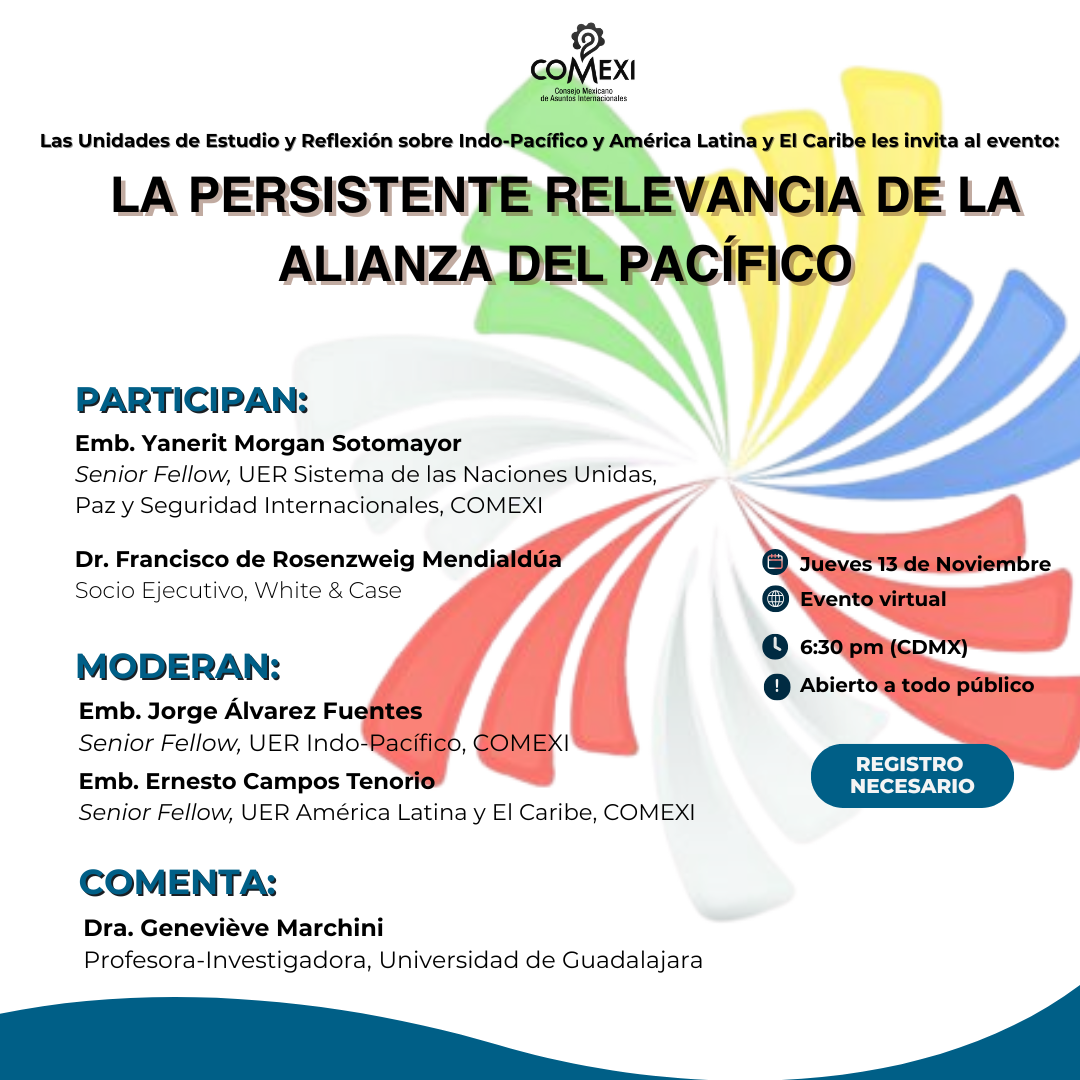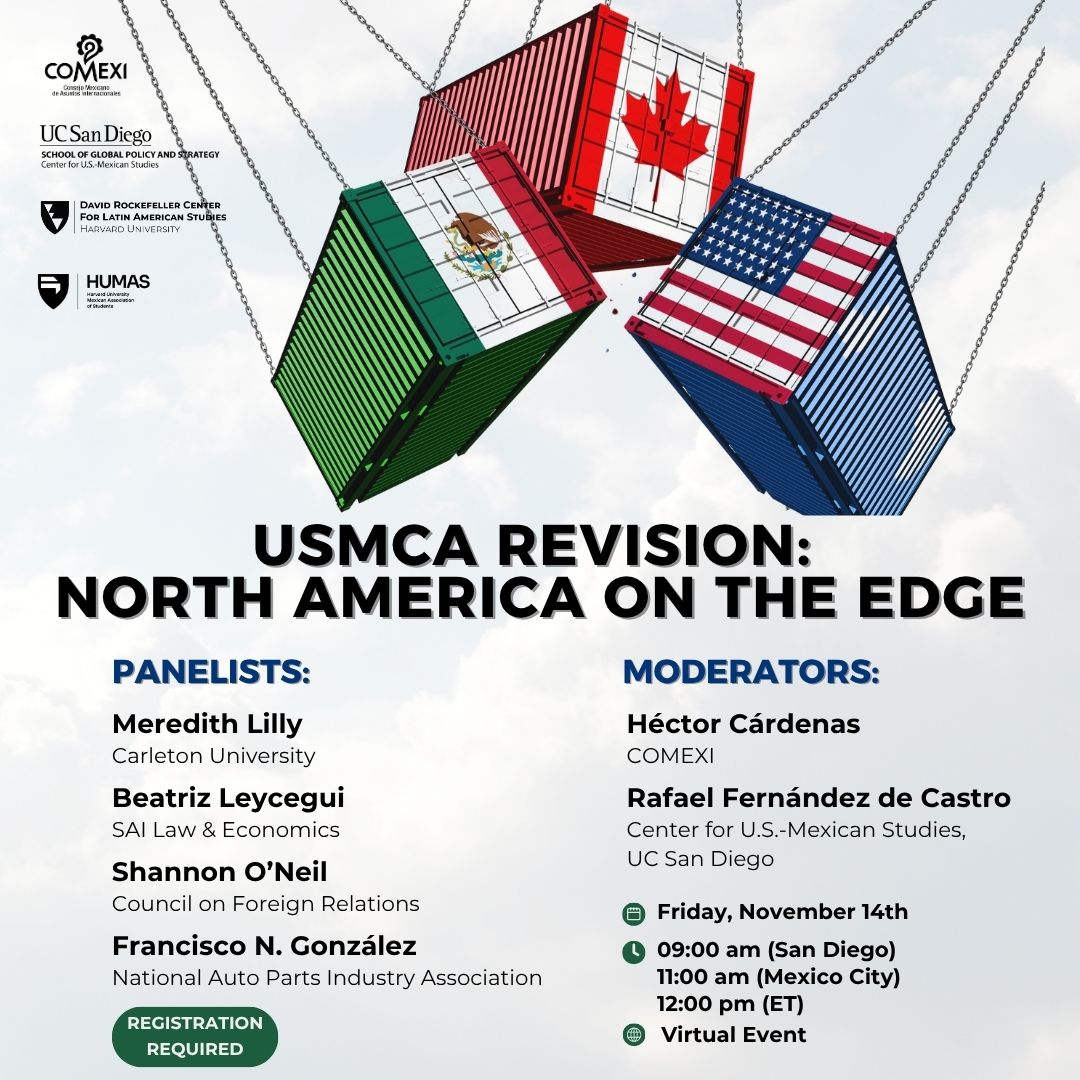El Consejo Mexicano de Asuntos Internacionales (COMEXI), presenta el webinar "El despertar empresarial ante los retos globales" en colaboración con Arizona State University (ASU) y the Thunderbird School of Global Management. En este webinar, el Dr. Sanjeev Khagram (Director de la escuela de Administración Global de Thunderbird) discute junto con la Mtra Norma Munguía (consultora ambiental y Asociada COMEXI) los principales impactos del COVID-19 en el sector empresarial, económico y gubernamental.
The Mexican Council of Foreign Relations (COMEXI), presents the webinar "The business awakening to global challenges" in collaboration with Arizona State University (ASU) and the Thunderbird School of Global Management. In this webinar, Dr. Sanjeev Khagram (Dean and Director of the Thunderbird School of Global Management) discusses the main impacts of COVID-19 in the business, economic and government sector along with Norma Munguía (environmental consultant and COMEXI associate).
After Norma Munguia welcomes the audience, she gives a brief introduction specifying the importance of understanding the current COVID-19 crisis in health terms, as well as how it will affect the global economy. Dr Sanjeev Khagram then starts his presentation by saying that before analyzing the current situation of the businesses and the economy, one must remember how it all was pre coronavirus crisis.
Although it has changed in a matter of three months, prior to the pandemic the world was living a fractured globalization, with companies working towards a new era of digitalization and the economy transitioning towards a digital interconnection, at the same time it closed its political relations. Also, there was low economic growth with the world heading towards a soft landing (slow contraction) and an estimated of 2-3% of annual global growth by the end of the year.
He describes that there was also a massive urbanization with internal migration increasing in developing countries from the agricultural sector to the more specialized ones in the cities. Economies that once had an important workforce such as China are now suffering a shortage in working-age population while other emerging regions in Latin America and Africa are in the opposite situation.
Furthermore, continues Dr. Khagram, the nature of skill sets and fluencies needed for the 21st century were rapidly changing with transformations for enterprises and people in new technologies such as the internet of things (IOT), artificial intelligence (AI) and digital communications. These meant that business was changing but also the way of living, with new skills required not just to work but to live in the interconnected society.
Another situation pre COVID-19 was the rise in populisms and nationalisms. The wave of the latter in eastern Europe and in Latin America began to worry international organizations. It also meant that the power was transitioning to Asia because western multilateralism began to change towards more unilateral agendas while the eastern countries opted for regionalism. This affected not only geopolitical areas, but also international environmental agendas.
He specifies that even prior to the current situation, climate change was a demanding issue. It was urgent, and red flags such as the Australia fires in early January (which he saw first-hand) alarmed governments all around the world and yet, no action was taken. The lack of environmental cooperation and the disregard of new green technologies in nations such as the United States made it difficult to mitigate. These technological advancements that were already happening needed a transformation towards a green mindset, but they also meant disruptions in businesses.
All these, summarizes Dr. Khagram, is still happening, but the coronavirus and today’s circumstances will accelerate them. Once the COVID-19 started, the world suffered important impacts and countries began to take different actions, with some thoroughly working to flatten the curve, those still considering if the best strategy is lockdown, while others suffered because of their inaction. But, he continues, in the broader perspective, the world had two factors that influenced its decisions.
First, the goal is to ensure public health and economic safety. While the social distancing and isolation worked in some countries, others, like Italy and Spain took too long; but these examples of late decision-making have prompted responses around the world. Second, there is great pressure in the economic sectors to open lockdown, not just from big industries, but from micro enterprises. This has been exacerbated in the United States because of unemployment, which has reached a total of 20 million people.
He proceeds to describe how the global economy has been affected. When the coronavirus began in late November and started spreading in January, specialists drew four models:
- The virus was stayed localized in China, which estimated a decrease from 3% annual growth to 2% (mainly because the Chinese factories had to close and this affected companies all around the world);
- Middle expansion, concentrated in the Southeast Asian region, which approximated global growth between 2% and 1.5% (again because of the value chains shared between Asian countries);
- Deeper expansion throughout the world but not a pandemic would have meant a global growth of 0.5% to 0%;
- A global pandemic, which estimates a global contraction of -3% with recession (and even depression) for two to three quarters.
Therefore, continues Dr. Khagram, if current scenarios, number four in this case, continue, the world will have an economic transformation, require social changes and it will suffer an international power transition. For example, if all stays in course, China could become the biggest economy in three years. This means that the trends that were present before the COVID-19 crisis, are accelerating. Although the global economy has been hit by the coronavirus, it has also suffered great changes because of the oil price competition, affected greatly by less use of transportation, working from home dynamics and a paused air travel system in many countries.
Industries are also rapidly changing. Dr. Khagram identifies recreation, transportation, even agriculture and direct communications as the sectors with more decline. The lockdown has changed economic dynamics and labor supply will increase greatly in the following quarters, but the problem is that by the time the isolation is over, the business model will have adapted greatly to digitalization and new skills may be required in order to get a job back.
The latter, he proceeds, is related to how other businesses have benefited, mainly the digital sector. This means that companies will transition towards new models and activities. For example, apps have increased their revenues and their visibility, while even the gaming sector has had a surge in the last month. However, many still have confidence that business will thrive once the pandemic is over. Although the hope exists, there are still many “ifs” for going back to normal: How will it affect social interactions? Will there still be fear for interacting in restaurants and other public spaces? On the positive side, people will look for social activities after being in lockdown and this could trigger new ways of interaction.
Continuing with the pandemic scenario, he proceeds to talk about unemployment. Those sectors that have been strongly affected are the direct services (such as restaurants, cinemas, theatres, etc.), retailers (local shops and family businesses), transportation and manufacturing. This last one will see important changes in the following years not only because of further automatization, but it will decentralize its production centers away from China. On the arts and recreation sector, streaming has played an important role and it could mean the end of traditional face to face entertainment such as theatres.
Dr. Khagram also analyzes the government responses around the world. He identifies different timing in responses and clarifies that it depends greatly on the supported industry. From rate cuts, tax cuts, spending increases, to market support and bank measures; they all depend on the country’s capabilities. Even though there has been a common support for small companies, it is important to understand that, while gravely hit, these are the ones that will have an easier rebound to economic activities. Family businesses, for example, have less employees and have social closeness to their neighbors. The local communities will want to buy in a safe space before going to big retailers and supermarkets.
In the business sector, however, the response will be a pivoting towards digitalization, describes Dr. Kharam. The challenges that arise could vary from new skill sets, to innovation. Furthermore, employment is suffering important changes: this is the first crisis lived by generation Z and, as they enter the global market, they have skills that even millennials will have to compete to. The young workforce is a competitive advantage for some countries, but to others, it means that their age gap is going to hit harder.
He then presents a series of silver linings, positive aspects of the COVID-19 crisis. Innovation, for example. Not just in digital & health, but also in governmental responses, prevention plans and work dynamics. Businesses will transform, with new processes, towards a more flexible working environment derived from the home-office adaptation, which can reduce costs and environmental impacts of transportations.
However, globalization can face great challenges and could end the way countries manage their production while societies also change their opinion of it. Inequality, an already growing problematic, is likely to rise due to the pandemic. Accompanied by unemployment, it will mean greater political pressure for governments with increasing unequal social conditions.
On the other hand, he continues, the world cannot forget the planetary limits. There is less air pollution because of the lack of transportation and industrial compound activities, and it has been called the return of nature with animals roaming cities and better water conditions. Nevertheless, if the push for rapid economic acceleration continues and the rebound measures are not focused on green infrastructure, it is very likely that the planetary boundaries will be reached faster, bringing another global emergency. Nations, specially oil producers, need to invest in climate transformation that address mitigations and adaptation to climate change and global warming.
Furthermore, adds Dr. Khagram, the fourth industrial revolution will accelerate, and companies will have to adapt faster to global competition. It could bring new jobs that require new skills, so capacitation and education are important factors. Reskilling the older generation can add competitiveness against States that have a younger workforce. This requires a more digitally interconnected society that cooperates towards sustainable profit.
He concludes by identifying three trends. First, rise of China is likely to happen in the next three years, consequence of the current crisis. However, it is important to note that countries and businesses are reconsidering China’s role as a producer, and could decentralize their production lines, moving their industrial chains to other countries or even bring them home.
Second, the push for economic recovery will have a short-term perspective. It means that industries will rebound in a fast way, without thinking in the long-term needs such as reskilling and environmental impact. Third, the pandemic is not yet over and there is no way of knowing when it will end. Nonetheless, this uncertainty should pivot businesses and people towards a more interconnected and multilateral globalization that solves issues of inequality and sustainable growth.
After Dr. Khagram finishes, the dialogue opens for a Q&A session. The first and second questions are: Was Mexico following an economic downfall before COVID-19 with the current administration? What should have been done before the coronavirus became a pandemic? To the first one he answers that Mexico was in the same circumstances as the rest of the world, with little investments, trouble in trade and slow economic growth.
Second, he continues, one of the key points is prevention and identifying sick people, meaning that testing was, and still is, the best tool. South Korea is an excellent example, being geographically near to China. It is a country that, through testing, was able to outrun the sick curve, isolating the cases and the country was so efficient at this that they even held a national election.
The next question is how will the current crisis affect Mexico’s industry and how could it pivot towards a more digital economy? Dr. Khagram answers that the supply will change, and the decentralization of industries away from China could benefit the Mexican economy. The trend of regionalisms and the new USMCA could also be advantageous. However, another scenario is that, because of the same reasons, countries could return their industries to their homeland, which could mean the loss of more foreign investment.
Furthermore, even with promising scenarios, businesses will need to invest in reskilling their employees. The crisis will bring further digitalization of markets and automatization of industries.
Then, Dr. Khagram answers the following question: Is it possible that, what really drove the countries’ reaction of isolation and emergency measures was the economic consequences rather than the health implication? He argues that the response has been greatly influenced by the economic impact, but this is highly connected to the contagion rate. If it hadn’t been so important to close the nonessential activities, then the economy would not have been hit as hard. Yes, the economic motivation is there, but it is related to the health implications. However, the unemployment rate and the uncertainty have urged for a faster response to flatten the curve.
The last question is related to the transition towards new technologies in businesses after the COVID-19: What options do companies have towards green economy and tech-based solutions for inequality and environmental challenges? He explains that the world needs every solution in the technical, social and economic spheres as soon as possible, even before the coronavirus crisis is over. The technologies are a need, not a luxury, with zero-carbon materials and industries.
COVID-19, continues Dr. Khagram, has triggered a response of billions of dollars to assess, mitigate the problem and work towards a solution. He would like to see the same actions taken soon against climate change, with innovation, infrastructure, skilling in the green economy. Retaking the previous topic of artistic and recreation changes, he concludes that the crisis should pivot towards more cooperation and interaction between humans, who are cultural beings: Art and music, is what we live for; people work to live, but they don’t live to work. How much the digital world can give us that meaning, the connectivity, is an open question. As we feel the isolation impacts and psychological weight of the quarantine, it is impossible to ignore the importance of museums, art and culture. Beyond the health and the economy, these are part of who we are, this is what makes us human.
Elaborado por Alejandro Hernández Buen Abad





